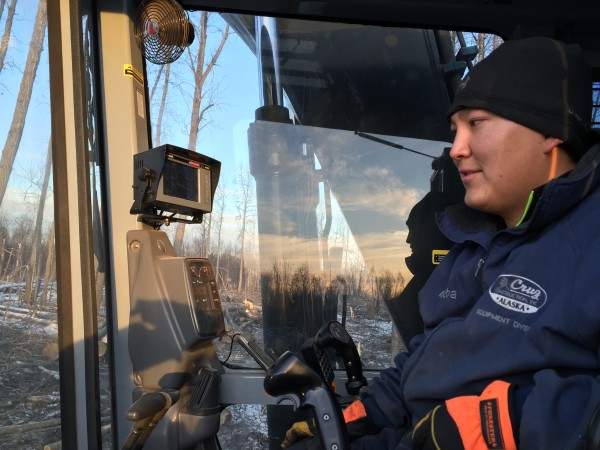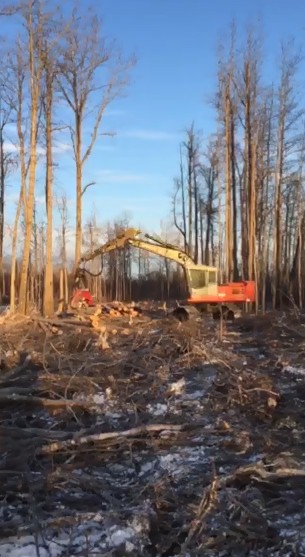Large-scale logging on the Yukon River started about a hundred years ago, when steamships burned a cord of wood per hour to power their engines. Village residents clear-cut wide swathes of forest along the river, but the logging tapered off when ships switched to diesel. These days, villages like Galena are once again looking to the forest for an energy supply.
But this time around, a new generation of loggers is thinking more about sustainability in how – and why – they harvest trees from around their communities.

The first sizeable timber harvest in decades is now underway just west of Galena, in low-lying cottonwood-dominated forest. It’s a patchwork of spindly, tangled undergrowth and scattered pockets of mature cottonwood trees.
Bubba Aloysius is at the controls of a danglehead processor, plucking one tree at a time from one of these pockets. It is only his second day on the job, but he already talks like an old pro.
“It’s your basic excavator controls as far as the boom attachment and all that, then you have you button controls which control the implement itself, grapple arms, the wheel, the measurement, the saw, the way it turns.”

It’s a far cry from the two-person whipsaws that were the tool of choice in the last logging boom a hundred years ago. The business end of this rig is a sort of Swiss Army knife of logging tools: a chain saw, grappling arms, and ferocious looking wheels with sharp teeth that can strip bark and snap off branches.
Aloysius maneuvers the controls to grab a tree, and then cuts it down in just a few seconds.
Aloysius has operated all kinds of heavy equipment on construction projects and oil field work, but feels like this job is different.
“It’s something that has got to be done around here. It’s good for the future of Galena, and I wanted to be the man to do it.”
The harvested wood is part of a plan to bring long-term economic stability to Galena, by switching the former Air Force Base from diesel heat to wood. The base is home to the Galena Interior Learning Academy – a boarding school and the major employer in town.

A new group called Sustainable Energy for Galena Alaska is in charge of supplying the wood. But without any experience with industrial logging, the group had to bring in some experts like Shawn Champagne, who is involved with the biomass energy project in Tok.
Champagne says a big part of his job is to teach experienced equipment operators to become responsible foresters.
“Your job changes every day, and you feel like you’re doing a good job. You feel like you are helping Mother Nature. In the old times, fires redid everything. And now that we are stopping the fires, the forests are dying from being too old. So a good forester will tell you that logging is beneficial to the woods – if you do it right.”
Tim Kalke is trying to make sure the timber harvest is done right. He manages the logging operation, and wants to make sure that his crew is picking the trees that will fit nicely in the wood chipper later on, but also choosing to leave some trees behind as habitat for birds and other animals.
Kalke is also a high school teacher. He recently brought his natural resource management students out to the harvest site for a lesson on how logging can be sustainable.
“I told them the other day that they were the last students to stand in that patch of trees. And they all looked at me with kind of a horrified look, because it was beautiful and it was nice. And then I said, ‘for about 45 years.’ And they made that connection, ‘…Wait a minute, you know, we are using this local resource, as a fuel, and it’s renewable, it’s gonna come back, if we do it right.’”
Students in the school’s vocational program may also get some hands-on experience with turning local timber into finished products. Cottonwood is relatively soft and doesn’t splinter, making it a good choice for things like picnic tables and railings.
Back at the rig, Aloysius spins the wheels of the processor and 30 feet of tree shoots out the other side.
Then the chain saw quickly slices through the tree, and another stick of cottonwood joins the growing pile.
Aloysius and his crewmates are trying to finish the timber harvest before Christmas… not that cold weather would bother him in the cab of the danglehead processor, which features a very nice heater, a comfortable seat, cup holders and a radio – even more stuff that loggers didn’t have a hundred years ago.




